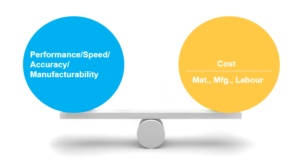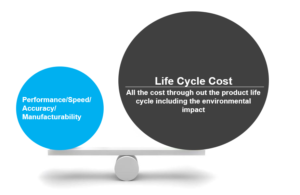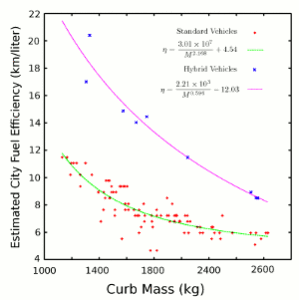Trade-off, to my opinion, is the major reason of optimization driven design. Trade-off among performance, time to market, regulatory requirements and all this at a right COST.

However, while calculating cost, a broader view taking all the processes for the whole life cycle of the product including the impact on the environment is necessary to take the true picture into the consideration.

Let’s take an example: an engine mounting bracket made of aluminium manufactured through high pressure die casting (HPDC).
Typically, following are the stages to be considered while doing the life cycle cost calculation for such a bracket:
- Primary aluminium production
- Transportations
- Manufacturing
- Operation
Let’s go in details of calculations for each of the stages:
- Primary aluminium production
According to GHG Protocol there are total 9 sub sections of calculating the amount of CO2 emissions per 1000 tonnes of aluminium production, we will consider Soderberg method for our calculation:
- Prebake Carbon Dioxide emissions – 0 tonnes
- Soderbergh CO2 emissions – 1782 tonnes
- Alternative method for electrolytic process CO2 emissions based on consumption of purchased – 0 tonnes
- Default factor method for electrolytic process CO2 emissions –0 tonnes
- Coke calcination CO2 emissions – 275 tonnes
- CO2 emission from soda ash used in the aluminium production – 0 tonnes
- Lime production CO2 emissions – 887 tonnes
- Perfluorocarbons (PFCs) emissions – 6429 tonnes
- Default PFC emission – 0 tonnes
So, the total CO2 emissions during primary aluminium production – 9373 tonnes per 1000 tonnes aluminium – or, ~94 kg per 10 kg aluminium.
- Transportations
To calculate the total carbon foot print due to the transportation, we need two things: total life cycle transportations (in KM) and the correlation between the distance travelled and its equivalent carbon emission.
Given that the distance between Kashmir and Kanyakumari is 2856 Km and both the primary aluminium producer, the foundry as well as the OEM is based out of India, it is assumed that total lifecycle travel during all the stages of the production of the bracket is 1900 Km.
Now to find the correlation between the distance travelled and its equivalent carbon emission, we first need to find correlation between mass and its equivalent fuel consumption. And for this, I have taken reference of this research findings from Stanford University students:

Which roughly translate as 0.004375 Kmpl per Kg, or in other words, 83 litres of diesel for the 1900 Km life cycle travel for the 10 kg aluminium bracket.
Next, we also must find out the correlation between the litre of diesel burn and the amount of CO2 emission. For doing so, we will again take the help of the stationary combustion tool of Green House Gas Protocol. According to it, each litre of diesel is equivalent to 0.003 tonnes of CO2.
Combining both correlations, we got that total CO2 emissions for the lifecycle travel (1900 Km) of the 10kg aluminium mounting bracket – 249 Kg.
- Manufacturing
To calculate the CO2 emissions while manufacturing the bracket, I am going to refer the research on “Energy Consumption of Die Casting Operations” carried out by U.S Department of Energy. According to this, total Carbon Dioxide emission for manufacturing 10kg aluminium bracket in HPDC is 25 kg.
- Operation
In order to calculate the total operation CO2 emission, here, we are assuming that the bracket (10 Kg), in question, will be used in a passenger car and the design life of a passenger car is 250000 Km. Using the same methods as used in transportation emission calculation, we can arrive at 32813 Kg CO2 emission for the total operation during the whole life cycle of the bracket.
Adding up all the CO2 emissions in various stages we got the total emission value for the bracket as 33181 Kg- CO2.
Show me Money
We will use the GHG tool again to calculate the total CO2 emission equivalent to Diesel. And the 33181 Kg-CO2 translated to 11060 Litres of diesel. With INR 75 per litre, the total carbon footprint cost stands at INR 8,29,519. If we add the material cost (INR 145/Kg), the total cost, excluding direct labour, stands at INR 830956 or 0.8 Million.
To bring it into prospective, the 33181 Kg-CO2 also means it requires 1580 trees in order to negate the environmental effect within one year or 316 trees in case the negation period is five years.
So, to summarize:

Hi, I am Shibashis, a blogger by passion and an engineer by profession. I have written most of the articles for mechGuru.com. For more than a decades i am closely associated with the engineering design/manufacturing simulation technologies. I am a self taught code hobbyist, presently in love with Python (Open CV / ML / Data Science /AWS -3000+ lines, 400+ hrs. )
